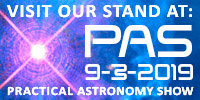Astronomers suggest new way to image black holes
A new algorithm that could help astronomers produce the first image of a black hole has been developed

An artist’s impression Cygnus X-1, which formed when a large star caved in. This black hole pulls matter from the blue star beside it. M.Weiss/NASA/CXC
Researchers from MIT’s Computer Science and Artificial Intelligence Laboratory and Harvard University have developed a new algorithm that could help astronomers produce the first image of a black hole.
The algorithm would stitch together data collected from radio telescopes scattered around the globe, under the auspices of an international collaboration called the Event Horizon Telescope. The project seeks, essentially, to turn the entire planet into a large radio telescope dish.
“Radio wavelengths come with a lot of advantages,” says Katie Bouman, an MIT graduate student in electrical engineering and computer science, who led the development of the new algorithm. “Just like how radio frequencies will go through walls, they pierce through galactic dust. We would never be able to see into the centre of our galaxy in visible wavelengths because there’s too much stuff in between.”
But because of their long wavelengths, radio waves also require large antenna dishes. The largest single radio-telescope dish in the world has a diameter of 1,000 feet, but an image it produced of the Moon, for example, would be blurrier than the image seen through an ordinary backyard optical telescope.
“A black hole is very, very far away and very compact,” Bouman says. “It’s equivalent to taking an image of a grapefruit on the Moon, but with a radio telescope. To image something this small means that we would need a telescope with a 10,000-kilometre diameter, which is not practical, because the diameter of the Earth is not even 13,000 kilometres.”
The solution adopted by the Event Horizon Telescope project is to coordinate measurements performed by radio telescopes at widely divergent locations. Currently, six observatories have signed up to join the project, with more likely to follow.
But even twice that many telescopes would leave large gaps in the data as they approximate a 10,000-kilometre-wide antenna. Filling in those gaps is the purpose of algorithms like Bouman’s.

Radio waves are able to penetrate through cosmic dust. Image Credit: NASA
The Event Horizon Telescope uses a technique called interferometry, which combines the signals detected by pairs of telescopes, so that the signals interfere with each other. Indeed, CHIRP could be applied to any imaging system that uses radio interferometry.
Usually, an astronomical signal will reach any two telescopes at slightly different times. Accounting for that difference is essential to extracting visual information from the signal, but the Earth’s atmosphere can also slow radio waves down, exaggerating differences in arrival time and throwing off the calculation on which interferometric imaging depends.
Bouman adopted a clever algebraic solution to this problem: If the measurements from three telescopes are multiplied, the extra delays caused by atmospheric noise cancel each other out. This does mean that each new measurement requires data from three telescopes, not just two, but the increase in precision makes up for the loss of information.
Even with atmospheric noise filtered out, the measurements from just a handful of telescopes scattered around the globe are pretty sparse; any number of possible images could fit the data equally well. So the next step is to assemble an image that both fits the data and meets certain expectations about what images look like. Bouman and her colleagues made contributions on that front, too.
The algorithm traditionally used to make sense of astronomical interferometric data assumes that an image is a collection of individual points of light, and it tries to find those points whose brightness and location best correspond to the data. Then the algorithm blurs together bright points near each other, to try to restore some continuity to the astronomical image.
To produce a more reliable image, CHIRP uses a model that’s slightly more complex than individual points but is still mathematically tractable. You could think of the model as a rubber sheet covered with regularly spaced cones whose heights vary but whose bases all have the same diameter.
Fitting the model to the interferometric data is a matter of adjusting the heights of the cones, which could be zero for long stretches, corresponding to a flat sheet. Translating the model into a visual image is like draping plastic wrap over it: The plastic will be pulled tight between nearby peaks, but it will slope down the sides of the cones adjacent to flat regions. The altitude of the plastic wrap corresponds to the brightness of the image. Because that altitude varies continuously, the model preserves the natural continuity of the image.
Of course, Bouman’s cones are a mathematical abstraction, and the plastic wrap is a virtual “envelope” whose altitude is determined computationally. And, in fact, mathematical objects called splines, which curve smoothly, like parabolas, turned out to work better than cones in most cases. But the basic idea is the same.
Keep up to date with the latest space news in All About Space – available every month for just £4.99. Alternatively you can subscribe here for a fraction of the price!




